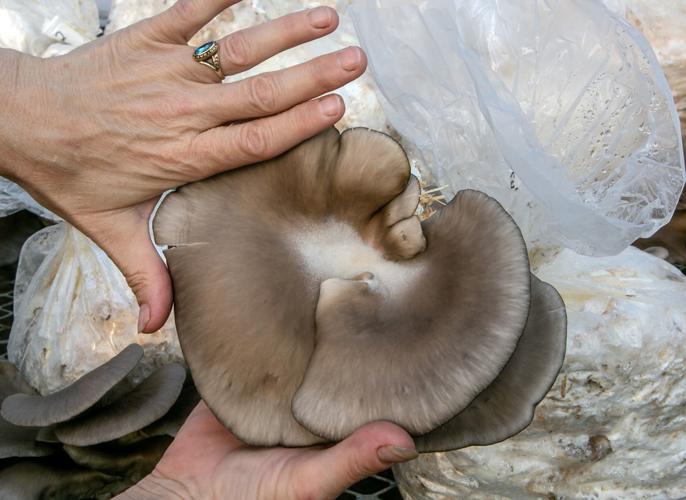Matt Silverton admits that as a gardener he’s got a black thumb. Except when it comes to fungi.
“I could never grow a plant,” Silverton says, “but I can grow mushrooms.”
Silverton is a co-organizer of the Arizona Mushroom Growing Group, a bunch of ’shroom-gardening enthusiasts who are figuring out the best ways to grow mushrooms in Tucson.
His and others’ experiments are housed in a small section of a small greenhouse at the Las Milpitas de Cottonwood community farm. The Community Food Bank of Southern Arizona provides the space.
A waist-high, maybe 10-foot-long shelf is divided into sections where each participating member grows oyster mushrooms, the easiest kind to grow in Tucson. The shelf is full of 5-pound bags and 5-gallon buckets that contain growing material from which mushrooms grow.
The growers share the cost of the misting system that helps maintain the ideal humidity for growing. A floor-to-ceiling white plastic curtain also helps keep the humidity in.

Matt Silverton looks over bags of growth material, called substrate. Mushrooms can sprout from a variety of mediums — even a wet paper bag.
EXPERIMENTS UNDERWAY
Silverton is experimenting with different types of material in which oysters grow, including straw and hardwood sawdust. He’s also trying out other varieties of oysters, including phoenix and yellow.
George Hubbard has put his bags of growth material — called substrate — on a tray of wet coconut husks. He wants to see if the husks will help create higher humidity that remains constant.
While showing his project to a recent visitor, Hubbard also harvested a handful of mushrooms that he planned to cook that day.
“I love ’em,” he says. “I like to saute them in butter and little bit of garlic.”
He also likes to make quesadillas with mushrooms and onions. He dehydrates some of his harvest so they keep longer.
Maria Spangler grows mushrooms in sterilized grain, an easy material in which to grow blue oysters. Her experiment is to teach herself how to cultivate this crop.
“It’s fascinating to watch them grow,” she says. The best result so far: “I can eat fresh mushrooms.”

Retiree George Hubbard examines one of the mushrooms he has grown. The hobby is not water-intensive, growers say, with mushrooms needing only localized humidity.
Nyles Bauer formed the group on a social website called Meetup. At twice-weekly meetings, he, other members and guest speakers share how they tease spores or cells into mycelium that will issue mushrooms.
Some meetings focus on growing basics. Others can include discussion of petri dishes, substrate sterilization and optimum humidity. They talk about the best substrate to use and how to obtain viable mycelium cells.
Some of the members are focused not only on growing for themselves, but to cultivate enough product for farmers markets. The deep details they discuss help improve yields.
But for the casual mushroomer, you basically need some cardboard and a mushroom to grow some.

Yellow mushrooms grown by Matt Silverton. He and other west-side growers share the cost of a misting system.
SIMPLIFIED GROWING
That simplicity is what Chad Borseth, retail manager for Native Seeds/SEARCH, is after in the mushroom-growing talks he give around Pima County.
“I want to bring it down to the level where people don’t worry about it too much,” says Borseth, who is not a member of the Meetup group.
He has grown mushrooms from a store-bought one kept in a wet paper bag. He admits there isn’t a high yield with some more casual methods like this, but he gets enough for his own culinary needs.
“A pound of mushrooms — you can do that on your kitchen counter,” he insists. “It doesn’t take a lot of space to grow a few mushrooms.”
Borseth likes growing mushrooms because it uses material that he would toss into the compost pile anyway: cardboard, coffee grounds, wood chips and straw.
Now, he can get one more use out of these materials before turning them into compost that will in turn be used to grow other plants.
Bauer says growing mushrooms uses far less water than other crops popular with Tucson gardeners. There’s a misconception that because of its need for humidity, a mushroom needs a lot of water.
“All they need is localized humidity,” says Bauer. That could be accomplished with misting in an enclosed space.
Other plants need a lot of water to keep soil moist, he says. “Mushrooms can beat them all.”
“My goal,” he says, “is to show 1 pound of mushrooms for 1 gallon of water.”










